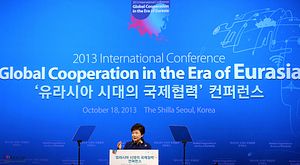Following up on the Blue House’s recent proposal for high-level talks, Seoul has continued to advance extensive plans for inter-Korean cooperation.
In line with President Park Geun-hye’s policies of “humanity, co-prosperity, and integration,” the Unification Ministry has proposed 96 new inter-Korean projects including support for the North Korean fishing industry, restoration of ecological systems, normalization of operations at the Kaesong Industrial Complex, and other key enterprises. In addition, Seoul announced on August 18 that it is considering providing maintenance service to the railroad connecting Kaesong to Sinuiju, a major entrepot for Sino-DPRK trade.
This is an interesting addition to Seoul’s North Korea policy because it hints at how the administration is using inter-Korean relations to advance its larger regional ambitions.
In October 2013, Seoul hosted the Global Cooperation in the Era of Eurasia conference where President Park outlined her economic vision for the region. Specifically, her “Eurasia Initiative” called for linking of energy and logistic infrastructure (such as rail networks, oil and gas pipelines, and electricity grids) across Europe and Asia. This integration was to be followed by the gradual elimination of trade barriers, leading to the establishment of a vast free trade zone. Part of this plan is clearly in motion with Seoul’s promise to finish negotiations for a free trade agreement with Beijing by the end of this year.
The Unification Ministry’s decision to consider helping North Korea bolster its transportation network also underscores Seoul’s commitment to Park’s Eurasia Initiative. South Korea could reap significant economic benefits by connecting the Kaesong-Sinuiju rail line to South Korea’s rail network, forming the trans-Korean rail (TKR). Indeed, once that was linked to the trans-continental Eurasian Land Bridge, overland shipping costs between South Korea to Europe would be slashed by over 30 percent, according to some estimates. This would be a huge boon to South Korean exports.
However, as always, Pyongyang’s foreign policy posture remains the obvious obstacle to Seoul’s vision.
It is not the only one, however. South Korean’s May 24 Measure sanctions on inter-Korean economic cooperation, which were implemented by the previous administration following the 2010 attack on the South Korean corvette Cheonan, also pose a major obstacle in negotiations between the two rival governments. Pyongyang has often demanded these sanctions be repealed as a precondition for further talks; however, Seoul is unwilling to risk the political consequences of appearing to reward Pyongyang for its bad behavior. This is especially true as North Korea’s provocations along the Northern Limitation Line flare up periodically. While the most recent proposals forwarded by the Ministry of Unification signals Seoul’s willingness to ignore some aspects of the sanctions, even the nominal maintenance of the May 24 Measure will likely remain a contentious issue.
Nonetheless, with South Korea struggling to expand its exports amid sluggish global demand, pressing economic imperatives may turn tempt South Korea to pursue more risky investments such as servicing North Korean transportation infrastructure.

































